In our day-to-day routines, we face the important responsibility of tending to the umbilical cord stump in newborns. Maintaining good hygiene and regularly checking for any signs of infection are essential aspects in safeguarding the health of our young patients.
However, there are nuances and best practices that can elevate our care to the next level, ultimately leading to better outcomes for these vulnerable infants. Let's explore how we can optimize our approach to umbilical cord care for term newborns to provide them with the best start in life.
Key Takeaways
- Proper cord care is essential for preventing infections and ensuring faster healing.
- Cleaning techniques involve gentle alcohol cleaning, keeping the area dry, and monitoring for infection signs.
- Signs of infection include redness, foul odor, swelling, and bleeding—prompt medical attention is crucial.
- Timely intervention for complications like persistent stump, bleeding, or granuloma formation is necessary for optimal healing.
Importance of Umbilical Cord Care
Why is proper umbilical cord care essential for newborns' health and well-being?
Taking care of the umbilical cord stump is important for our baby's health. By ensuring proper cord care, we can prevent infections and promote faster healing, reducing the risk of complications that could affect our newborn's well-being.
Keeping the cord clean, dry, and exposed to air is crucial for the healing process to occur smoothly. It's a simple yet significant task that can have a big impact on our baby's health.
Following the healthcare provider's instructions on cord care and being diligent in monitoring for any signs of infection are key aspects of ensuring our newborn stays healthy. Proper cord care is a fundamental part of newborn care that requires attention to detail and consistency.
Cleaning Techniques for Newborns

To properly care for your newborn's umbilical cord stump, gently clean around the base using a clean, alcohol-soaked cotton ball. Handling this delicate area with care is crucial to prevent any irritation or infection. Here is a helpful guide on how to clean your baby's umbilical cord stump:
| Step | Instructions | Frequency |
|---|---|---|
| Cleaning Technique | Use a clean, alcohol-soaked cotton ball to gently clean around the base of the cord stump. | 2-3 times a day |
| Keep it Dry | Make sure the belly button area remains dry and exposed to air to aid in healing. | Throughout the day |
| Change Diapers | Regularly change diapers to prevent moisture build-up around the umbilical cord stump. | Every diaper change |
| Monitor for Signs | Watch for signs of infection such as redness, foul odor, or discharge. | Daily check |
Signs of Infection to Watch For
Signs of infection to watch for in umbilical cord care may include redness around the base, foul odor, pus or discharge, swelling, and bleeding that doesn't stop. It's important to stay vigilant and recognize any concerning symptoms early on to prevent complications. If you notice any of these signs, don't hesitate to seek medical advice for proper evaluation and treatment.
Here are some vital indicators that may suggest an infection in the umbilical cord stump:
- High fever
- Excessive crying or irritability
- Red streaks on the skin
Best Practices for Optimal Healing

Proper care and attention to the umbilical cord stump are key to facilitating ideal healing and preventing complications. Keeping the stump clean, dry, and exposed to air is essential for promoting ideal healing. Avoid using harsh substances like rubbing alcohol on the umbilical cord stump as they can lead to irritation and infection. It's important to gently clean any fluids or stool around the stump with a damp cotton swab to maintain proper hygiene.
During this healing process, opt for sponge baths instead of tub baths until the umbilical cord stump naturally falls off. This helps prevent moisture-related issues that could impede healing. Monitoring for signs of infection such as redness, swelling, foul odor, or discharge is crucial for early intervention and ensuring the umbilical cord stump heals effectively. By following these best practices and maintaining good hygiene, we can support the healing process and minimize the risk of complications.
Timely Intervention for Complications
In our experience, timely intervention for complications related to the baby's umbilical cord stump is essential for ensuring the newborn's health and well-being. It's important to care for your baby's umbilical cord stump diligently to prevent any infection from entering the body.
If you notice any concerning signs such as redness, swelling, foul odor, or pus around the stump, it's important to seek medical help promptly. Additionally, if the stump hasn't fallen off within four weeks after birth, it may indicate underlying issues that require attention from a healthcare provider.
- Contact your baby's healthcare provider if:
- The stump hasn't fallen off within four weeks after birth.
- Signs of infection like redness, swelling, foul odor, or pus are present.
- Excessive bleeding or persistent granuloma formation is observed around the umbilical area.
Frequently Asked Questions
How Should the Nurse Provide Care for the Umbilical Cord?
We provide care for the umbilical cord by keeping it clean with warm water and gentle soap if soiled. It's important to keep the area dry, exposed to air, and change diapers frequently to aid healing.
What Is the Proper Care for Umbilical Cords of Newborns?
We keep umbilical cords clean and dry, avoiding alcohol or powders. Signs of infection like redness or odor mean we must act. Let the stump fall off naturally in 1-3 weeks, but if worried, contact a healthcare provider.
WHO Guidelines for Umbilical Cord Care?
We adhere to WHO guidelines for umbilical cord care, focusing on keeping the cord clean and dry for newborns. This practice reduces infection risks, aids natural healing, and avoids harmful practices. Following these recommendations guarantees good health for newborns.
What Will a Nurse Teach a New Mother Regarding Care of the Infant's Umbilical Cord?
In caring for your newborn's umbilical cord, we will guide you to guarantee it stays clean and dry. Proper hygiene, frequent diaper changes, and avoiding tub baths until it falls off naturally are essential for healing.
Conclusion
As nurses, we hold the key to revealing the secrets of perfect umbilical cord care for our precious newborns. By following the steps outlined in this guide with care and precision, we can watch over our little ones like diligent gardeners tending to delicate blooms.
Let's nurture, protect, and guarantee the healthy healing of these tiny connections to life. Together, we can pave the way for a bright and flourishing future for our newest arrivals.










